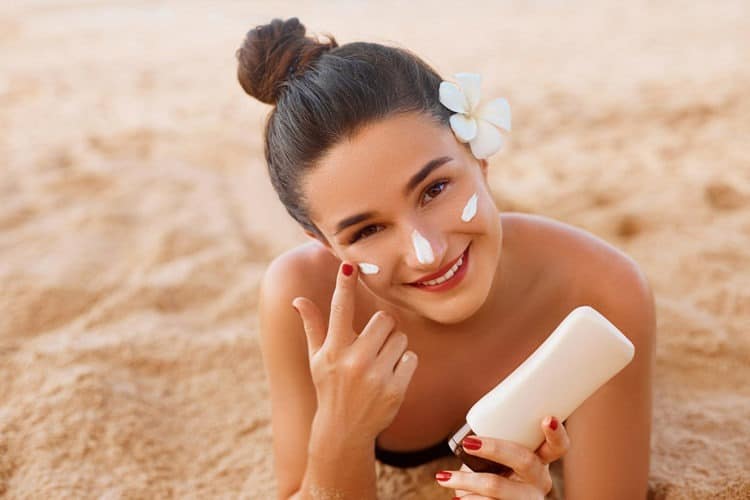Summer is coming to an end, but your tan is still going strong. Perhaps you’re tired of bronzed skin and want it to fade out. But it looks like it’s not going anywhere.
Are you stuck with it, or do you want to extend it as much as possible? But the real question is, how long does a tan last?
How Long Does a Tan Last?
On average, a tan will start to fade in 7 to 10 days, but it will take up to 30 days for a suntan to fade away completely, as your body gradually and naturally sheds the tanned skin cells, only to replace them with new ones. So, if you want your tan to last longer make sure to exfoliate before tanning, or simply apply a tan extender, and always moisturize.
It all has to do with the layers of your skin. There’s the epidermis which is your outer layer. In your early years of school, perhaps the snarky boy in your class told you your epidermis was showing to freak you out.
This is where it truly pays to know a thing or two about the human body. If you really want to freak someone out, tell them their dermis is showing. That’s the layer of skin that’s just under the epidermis.
So the epidermis serves as your body’s first line of defense for its largest organ. It turns dead skin cells into a protective layer. The healthy skin cells begin life at the bottom of the epidermis. They’re about a third of an inch down and spend their days reproducing.
But as they begin to mature, they start creating keratin. Keratin is a waterproof and fibrous compound that creates all kinds of cool things in your body. It builds your nails and hair. Even animals have keratin working for them in the form of claws, beaks, horns, hooves, shells, and scales.
For the human body though, when it makes fresh skin cells, the new push the old out and up toward the surface. This can take two to four weeks.
By the time those cells climb to the surface, it has more of the composition of a scale filled with keratin. It doesn’t contain the regular cellular composition. These surface cells hang on for about 30 days.
While not as cool as a snake shedding skin, you too shed your skin and you have new skin every month. Wild, isn’t it?
So, it takes up to 30 days to bid adieu to your suntan. But you can do a few things to speed along the process for your best results.
It helps to first understand a bit more about tans and your skin structure though, so keep reading and soon, you’ll know just how to get rid of your tan.

What’s a Tan?
Tans might look sexy, but the science behind it is incredibly fascinating. If you’ve ever learned about the human body and what it is capable of, you won’t be surprised in the slightest that your skin, the largest organ in your body, has a protective mechanism in place to protect your skin from the sun.
Skin cancer specialists explain that there are few cells in the bottom layer of your skin. That layer is called the basal layer located at the very bottom of the epidermis. Those cells are called melanocytes. Their job is to create a pigment that you might have heard of: melanin.
These cells are found sporadically through the skin, composing roughly 1% of it. It’s helpful to think of them as the tentacles of octopuses that bring packages of melanin to the skin cells surrounding them. Trippy, right?
Anyway, the melanin is given to protect the skin, particularly the nucleus. It will stay on top of the nucleus much like your winter cap that you’ll soon be dusting off from your winter wardrobe.
This melanin on top of the nucleus keeps it guarded from the UV rays of the sun. It soaks up some of those excess rays which are known to mutate skin cell DNA which would lead to skin diseases like skin cancer.
That doesn’t mean your skin doesn’t need to help of a good sunscreen though! The sun’s rays are incredibly strong and while this is a helpful mechanism, not protecting your skin is foolish and can be deadly.
The melanocytes detect UV radiation that comes from the sun. When they make this detection, they start making the pigment. New research shows that melanocytes might even have eye-like capabilities to start that melanin production.
Scientists were able to find rhodopsin in melanocytes. This is a photosensitive protein, the very same one your retinas in your eyes use to perceive changes in light. The testing revealed that these receptors help the melanin process begin much more quickly to help guard your skin.
If you have naturally darker skin, you have more active melanocytes working for you to make more melanin. Black skin has about the same amount of melanocytes, but it produces much more melanin than those cells located in fair skin.
But regardless of skin color, those melanocytes have nothing to do with losing your tan. The reason you lose that tan is because, as mentioned above, your skin sheds.
Perhaps the light bulb has now popped over your head. Aha! Of course! It all lies in the shedding of your outer skin layer. But is there a way to speed that up? How can I use this newfound scientific information to my advantage?
For the answers to all these questions and more, keep reading!

How Does a Tan Fade?
Every 24 hours, whatever it is you’re doing – working, sleeping, eating, exercising, talking, painting your nails, and anything else – your skin is hard at work, shedding away. You lose roughly one million skin cells in a full 24-hour day.
That outer layer that sheds off replaces itself somewhere between 28 and 30 days but those surface cells keep on flaking off over time while new ones grow below in the bottom layers of your skin.
The process of this skin cell death has a fancy word for it: apoptosis. The dead cells on the surface of your skin are mostly protein and fat, and they are what help shield you from the environmental stressors that you encounter daily.
That could be the sun, pollution, weather, and even a tanning bed if you use one (though we don’t recommend that you do!). This fully normal process happens to everyone and is designed to protect us.
As mentioned, that outer layer is a shell of its former self and the protein and fat it contains are the barrier. Even in colder months, the cycle of regrowth and shedding endures, but melanin production drops off.
UV radiation is greatly reduced during this time so those melanocytes stop making so much pigment. As time goes by, those heavily-pigmented cells shed away and the new cells move up. Because they have less pigment, they appear lighter which is why in winter months, your skin tone will be the lightest.
Don’t be fooled that you’re safe from the sun’s rays in winter though. It can still have a dangerous effect on your skin, especially if you’re out in the snow. Perhaps the rest of you is covered, but your face, eyes, ears, and neck must be protected.
Want to know what happens to that cool million of skin cells you lose every 24 hours? Take a look around you. Look at your computer. See the dust there? How about your windowsills? Your tables? Entertainment center? Look all around you and you’ll see dust build-up, most of which is composed of dead skin cells.
You’ll probably want to go clean that up, especially if you live with others (that’s their skin too!) but first, keep reading to find out about fading your tan!
Which Factors Contribute to How Long It Takes a Tan to Fade
There are a few factors that can make your tan fade slower or faster that you should know of before you try to sweep or dust away your tan. Read on and maybe some of these will be applicable to you!

■ Age
Because skin covers so much ground from head to toe, it is the largest organ your body has. Skin has three layers that it is composed of.
There’s the subcutaneous layer at the bottom, the dermis in the middle, and the epidermis on the outer layer.
The epidermis is incredibly thin and as mentioned, is made from those dead skin cells. They get continually replaced by the new cells that are created in the lower portion of the epidermis that move up to the outside.
The cell production cycle slows down with age though, much like everything else in the body.
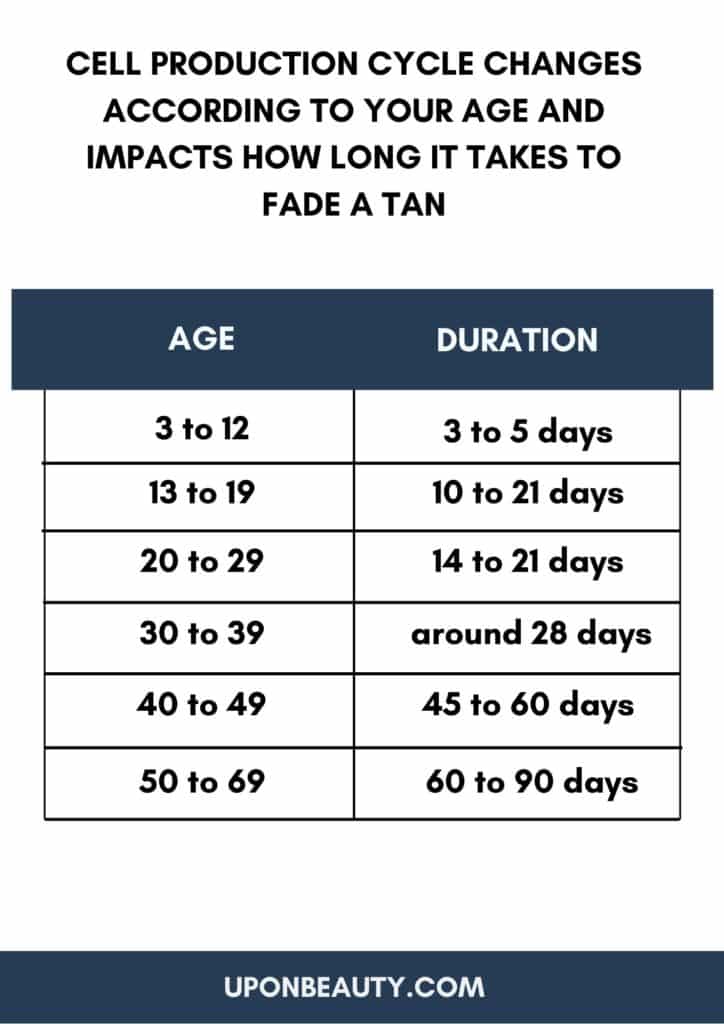
For most middle-aged adults, it can take around 28 days for the process to complete.But as the years pile on from there, the skin cycle slows down and it can take about 45 to 60 days when you are in your 40s or 50s.
It slows down to an even bigger crawl for those between their 50s and 60s at about 60 to 90 days. So in your youth, appreciate your skin.
Kids have it the best of all. Little ones take about 3 to 5 days which is why they have that gorgeous, bouncy, smooth skin. In your teens, it takes just 10 to 21 days.
Very likely, you didn’t realize then how important it is to care for your skin. If you’re in your 20s, you still have the chance to save your skin and protect it from damages, and your tan can fade in 14 to 21 days.
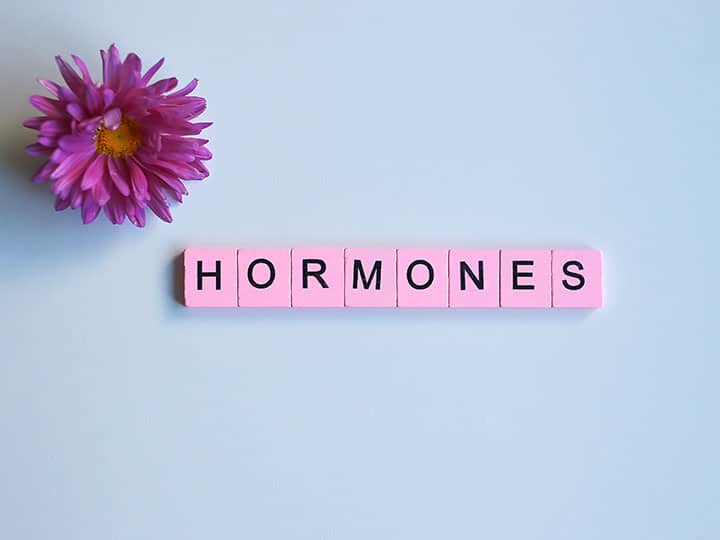
■ Hormones
Hormones play another role in the process of skin life cycles. One study found that the sex hormones estrogen and progesterone are crucial for regulating the synthesis of melanin in the body.
Researchers put on this cool experiment where they made a 3D replica of the human skin structure. They noted that the longer these cells were exposed to estrogen, the more melanin the cells made. In just a few days, they produced around 300% more melanin than before they had the melanin exposure.
The same test was conducted with progesterone. The synthetic version of this hormone is found in your birth control pills, known as progestin. During this test, the cells decreased melanin production. Fascinating stuff, simply because melanocytes don’t have hormone receptors, at least not traditional ones.
So, the researchers to another look at the molecular pathways. When they did, they found that the hormones open up special paths in the melanocyte cell membranes. These tell the cell to make more (or less) melanin.
Basically, what this discovery means for us is that it could pave the way for treatments for skin conditions like vitiligo. That’s the condition where skin loses its pigment due to the melanocytes being destroyed.
It also opens the door for potential to creating danger-free and non-toxic ways to change skin tone with cosmetics. An example would be to create a tan without any UV exposure or to make skin look more fair without bleaching. Isn’t science amazing?

■ Sun Exposure
There are times when you try to do everything right. You cover yourself with sunscreen, head to the pool or beach, and set up. The soothing sun feels so good. You pull out a book or magazine and start reading. The peacefulness takes you away and the next thing you know, you’ve taken a catnap. Now you’re red as a lobster.
Other times, perhaps you’ve been careless about your sun protection and found yourself a painful shade of red. Whatever the case when you have too much sun exposure, those UV rays go deep and past the outer skin layers and down into the deeper layers. This is dangerous because they can damage or kill off your skin cells.
While it’s likely that one sunburn won’t ruin everything, you absolutely must take care to never let it happen again. The more you have sunburn throughout your life, the more your skin will suffer for it.
It’s so easy in our youth to laugh it off, especially after you peel and your skin looks fine. But trust in the fact that sun damage from these early days will come back to haunt you when you’re older.
If you need more proof, look at older relatives that spent time in the sun without protecting their skin. They have age spots and leathery skin. You can prevent that from happening by protecting yourself in the sun every time.
Don’t go out in the sun without proper SPF protection and make sure you reapply it every hour to an hour an 20 minutes for the best results. You’ll thank your younger self someday when you turn up to your 20-year reunion and everyone looks old except for you.
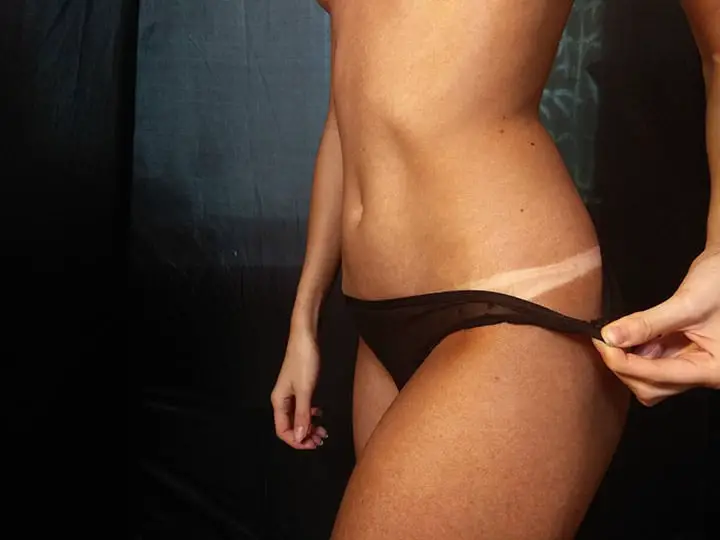
What to Do If You Want Your Tan to Fade Permanently?
If you want to get rid of your tan, there are a few things you can do to fade it away forever. Keep reading and you’ll be on your way to a fairer complexion soon!

■ Stay Away from the Sun
Tired of your tan? Then stay out of the sun. Even with proper protection, enough exposure to the sun will change the color of your skin. Never go out there without proper protection though because that will only make things worse.
Do you run or bike outside? You should take care to protect your skin when doing outdoor activities too. It will keep you safe from skin diseases and it will help you fade that tan away. Remember, reapply that sunscreen every hour to hour and 20 minutes to be sure you’re covered.
If you can, don’t go out into the sun for long periods between 10am and 4pm. That’s when the UV rays are the strongest. UV rays are also much more intense at higher altitudes (that’s for you people out on the slopes and mountainous areas), during late spring and early summer, if you live closer to the equator (that’s you, Florida!), and when you’re near reflective surfaces of any type.
Most people think of reflective surfaces as water, but on a sunny winter day, you need to beware of sun reflection from snow and ice too. Also, sand and concrete can reflect UV rays so those of you on the beach or hanging out by the pool need to pay attention to your surroundings and keep skin safe from UV damage.
■ Apply Aloe Vera Gel
Research has proven aloe vera effectiveness for soothing sunburn. But it does a lot more than cool red-hot skin. This natural anti-inflammatory for skin also helps squelch the release of melanin and reduces your chances of pigmentation.
Fading a tan fast may be as simple as using a great aloe vera gel, like this one by Seven Minerals aloe vera gel to help soothe and soften skin, and fade it back to a lighter shade.
Aloe vera contains a number of ingredients that work in a variety of ways to fade sun spots, discoloration and other skin problems.
Seven Minerals pure aloe vera gel is made with 100% pure aloe vera, which comes from freshly cut aloe vera plants.
It absorbs fast and helps skin retain moisture for hydrated skin. It doesn’t feel greasy or heavy after application, so it can be used under makeup if desired.
This aloe vera gel doesn’t just help fade a tan; it can be used to heal your skin after suffering burns or rashes too. It can also help keep acne at bay, reduce signs of aging and moisturize the sensitive skin on babies’ faces and ears, as well as any other place on your body.
■ Exfoliate to Fade Your Tan
- For Acne Cellulite Dead Skin Scars Wrinkles
- Infused with Collagen and Stem Cell
If you want to speed things along in the process of fading your tan, exfoliate! Using a gentle exfoliation scrub like this one by M3 Naturals.
This scrub combines natural Himalayan pink salt with other skin-loving ingredients like apple stem cell extract, aloe vera, sweet almond oil, jojoba seed oil and grape-seed oil, which is something I have never seen before in an exfoliation scrub.
The combination of these ingredients makes for a delicate product that will deeply nourish your skin as well as slough off the top layer to reveal a brighter, more even complexion.
The smell is a wonderful, fresh, citrusy smell that everyone I let smell this immediately fell in love with, and the feeling of freshly exfoliated skin is like nothing else!
Another alternative would be to do it yourself at
One big thing you need to know though is that you should NEVER exfoliate prior to going into the sun. Those dead skin cells are there to protect your skin from the sun so when you remove them, you’re making it easier to catch a tan, or worse if you’re not protected, sunburn and sun damage.
Conversely, if you DO want a tan, you can exfoliate before sunning and then make sure you slather on a high SPF protection every hour on the hour to tan without damage.
■ Try a Turmeric Mask
Believe it or not, the bright yellow antioxidant-rich spice of turmeric can be used as a skin lightener. It’s revered in India for this purpose.
There is no hard and fast proof of this but one study did find that turmeric was helpful in protecting from sun damage when it was used in a skin cream. Turmeric was also shown to boost skin hydration the production of natural oils that protect the skin.
The one downside is that turmeric can stain. If you use it in your cooking (and you should, because it is very healthy and good for you!), you may have noticed it can stain your kitchen counters.
Turmeric can also stain your face and anything else it comes into contact with. You can try using it but you should immediately wash your face to remove any of the residue and keep your skin for becoming stained.
■ Give a Try to Black Tea Extract
Another natural way to fade your tan may be found in black tea extract. One study showed it was effective on guinea pigs but that remains to be seen on human skin. As black tea is dark, it could also cause staining so do be cautious when experimenting with natural applications.
■ Use Lightening Skin Products
There are tons of skin-lightening creams on the market now. They’re very popular in Asia where women revere lighter skin as beautiful and youthful.
According to the American Academy of Dermatology, you should look for a skin-lightening product that has either vitamin C, retinoids, glycolic acid, azelaic acid, or kojic acid. These are proven ingredients that can lighten dark spots or tans.
They do so by means of gentle exfoliation and encouraging the growth of new skin cells. Some even slow down melanin production to help prevent and reduce dark spots.
Please remember though, less is more. You should never get a product that has too many of these effective active ingredients combined or else it could cause irritation or other problems.
There are also treatments that a dermatologist should supervise. If you’re not careful, you can irritate your skin or cause dermatitis. When you overdo it with skin-lightening products, you can actually cause the opposite to happen and create permanent dark spots or discolorations which is so much worse!
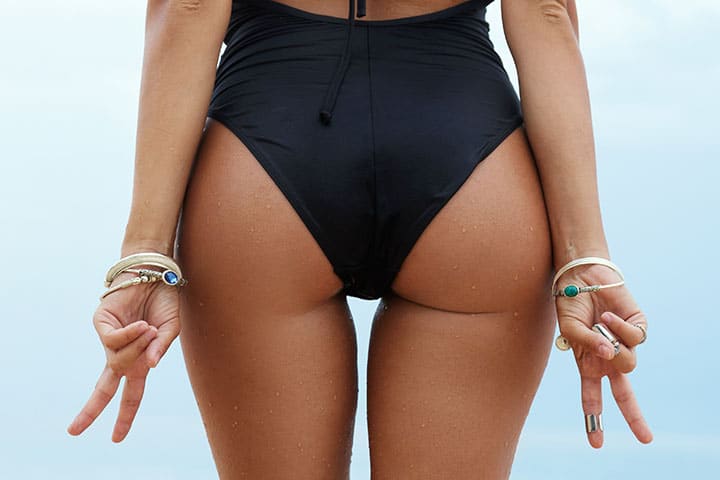
What to Do If You Don’t Want Your Tan to Fade?
But what if you want to make your tan last longer? You should carefully and safely continue your sun exposure to boost pigment in the skin cells. As mentioned earlier, you can exfoliate first and then protect your skin so you get the best and safest tan possible.
Conclusion
For most people, a tan will last for 2 to 4 weeks, which is the amount of time it takes your body to naturally exfoliate the tanned skin cells and regenerate itself, unless you continue your sun exposure.
If you must be out in the sun but don’t want to tan, use a strong sunblock to keep out all the rays or wear protective clothing. Make sure you’re reapplying your sun protection too.
You can fade away a tan by exfoliating gently and trying a few other tactics that could work for you. The best way though is to just stay out of the sun if you can. Be patient, and soon your tan will be gone, and so too, will be the days of summer.

